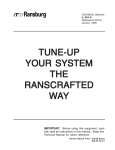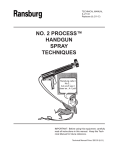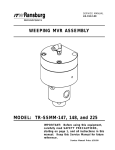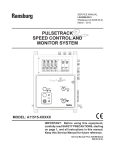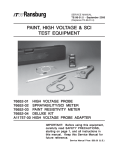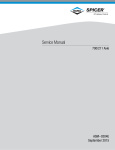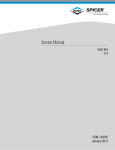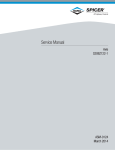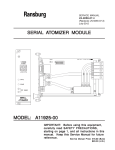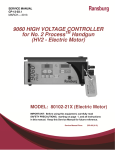Download tune-up your system the ranscrafted way
Transcript
Ransburg TECHNICAL MANUAL IL-204-E (Replaces IL-204-D) March - 2013 TUNE-UP YOUR SYSTEM THE RANSCRAFTED WAY IMPORTANT: Before using this equipment, carefully read all instructions in this manual. Keep this Technical Manual for future reference. Service Manual Price: €15.00 (Euro) $20.00 (U.S.) Tune-Up Your System the RansCrafted Way Ransburg NOTE: This manual has been changed from revision IL-204-D to revision IL-204-E. Reasons for this change are noted under “Manual Change Summary” inside the back cover of this manual. IL-204-E Ransburg Tune-Up Your System the RansCrafted Way CONTENTS PAGE THE RANSCRAFTED PROCEDURE: 1-11 TUNE UP YOUR SYSTEM THE RANSCRAFTED WAY.......................................................... 1 TUNE UP YOUR SYSTEM FOR THE MOST ECONOMICAL AND EFFICIENT PERFORMANCE.................................................................. 2 THE RANSCRAFTED PROCEDURE........................................................................................ 3 VISCOSITY..................................................................................................................................3 FLUID FLOW RATE.....................................................................................................................7 ATOMIZATION.............................................................................................................................8 THE OPERATOR.........................................................................................................................9 SUMMARY...................................................................................................................................10 IL-204-E Ransburg Tune-Up Your System the RansCrafted Way TUNE-UP YOUR SYSTEM THE RANSCRAFTED WAY DO NOT GAMBLE! Reggie Ransburg says: “Before you get into the game, find out what the rules are.” Before operating, maintaining, or servicing any Ransburg electrostatic coating system, read and understand all of the technical and safety literature provided with Ransburg products. If you do not have the manuals and safety literature for your Ransburg system, contact your Ransburg representative. Reggie says: “Why gamble? If you know how to play the game, you’ll be a winner.” 1 IL-204-E Ransburg Tune-Up Your System the RansCrafted Way TUNE-UP YOUR SYSTEM FOR THE MOST ECONOMICAL AND EFFICIENT PERFORMANCE Ransburg electrostatic coating equipment is designed and built to produce the desired finish in the production time allocated and to do it with the greatest efficiency of any spray coating equipment available. However, to get the most benefit from the equipment, it must be adjusted properly and control of the adjustments must be maintained. Some of the many variables inherent to any spray finishing operation are: 1. THE TARGET: (size, configuration and composition) It may be anything from golf balls, to cars, to musical instruments. 2. THE COATING MATERIAL: (composition and characteristics) It can be enamel, lacquer, metallic, high solids, waterborne, or almost any fluid. 3. THE DESIRED FINISH: Is it to be baked enamel, smooth, texture, or ...? 4. THE WORKING ENVIRONMENT: The primary environmental elements are cleanliness, ambient temperature, and humidity control. 5. THE EQUIPMENT: Is it Ransburg No. 2 ProcessTM (disk or bell), REA, REM, or M90. Is it hand or automatic? These variables are, of course, only a few of those possible throughout the industry. Every application is, in some way unique. Brief though it is, the list does indicate the impossibility of establishing universal adjustments that would apply equally to all installations. So, Ransburg has devised a procedure that will help the user to create a tune-up sequence for each individual operation. This RansCrafted process is the result of over 60 years of Ransburg engineering experience in originating and perfecting electrostatic coating. It is the product of extensive laboratory and field testing by the people who pioneered the industry. The three electrostatic coating parameters that are most easily measured and controlled are fluid: 1. VISCOSITY = - The Flow Resistance (of coating materials) 2. FLOW RATE = - The Applicator Output (measured in ounces or cc's per minute) 3. ATOMIZATION (Spot Size) = - Atomizing Air Pressure (REA Systems) - Fluid Pressure at the nozzle (REM and M90 Systems) - Atomizer Rotation Speed & High Voltage (No. 2 Process Automatic Systems) - Paint Resistance (No. 2 Process Manual and Automatic Systems) Control of these three parameters, Viscosity, Flow Rate, and Atomization can be maintained with optimum settings and allowable tolerances for any specific electrostatic coating system (regardless of the application requirements) by following the RansCrafted procedure. IL-204-E 2 Tune-Up Your System the RansCrafted Way Ransburg THE RANSCRAFTED PROCEDURE NOTE > This procedure MUST be followed in the exact sequence described. > The adjustment procedure must be performed for each application requirement variable (finish required, target configuration, etc.). > For specific details of how to make appropriate adjustments to your application equipment, refer to your Ransburg service manual or contact your Ransburg representative. VISCOSITY Viscosity, by definition, is the resistance to flow of a fluid. For the purpose of this procedure, think of it as the thickness or thinness of the coating formulation. Formulations of very low viscosity may be too thin and result in runs or sags in the applied coating. In spray coating operations, there are really two viscosities to be considered, the one at the atomizer and the one at the target. Of the two, the viscosity at the atomizer is the most critical and will differ in nominal value from that of the paint on the target. The difference is caused by solvent evaporation during the travel time from the atomizer to the target and by the method of atomization. To facilitate the best possible quality of atomization, it is necessary to keep the viscosity of the coating material at a point that is consistent with the application process while keeping in mind the nature of the coating material and the desired end result. The viscosity may be lowered by adding solvent to the formulation or by applying heat. If too much solvent is added, the viscosity may be increased again by adding paint solids. Because viscosity must be lower at the atomizer than at the target, the evaporation rate of the solvent becomes a critical factor. You want the viscosity at the atomizer to be low enough to produce good atomization, and the viscosity at the target to be high enough to prevent runs and sags. The controlling factor is the rate of solvent evaporation during the travel time. Careful selection of the solvent will produce optimum viscosity at both points. Solvents with relatively high evaporation rates cause an effective increase in paint viscosity during travel time and will therefore allow both good atomization and good coating quality. A discussion on viscosity must also be presented in terms of the type of equipment and the type of coating material to be used. It is important to understand that different types of equipment may require different viscosity and/or solvent selection. The viscosity requirements for Electric Rotators and Low Speed Air Rotators is different than that needed for the Turbodisk, Turbodisk 2, Aerobell, and Aerobell 33, and, that may be different from that required for REA, REM, and M90 applicators. 3 IL-204-E Ransburg Tune-Up Your System the RansCrafted Way Required viscosity for Electric and Low Speed Air Rotators is normally much lower than that needed for High Speed Turbine Rotators. The nature of the slower equipment is such that, because rotating speeds are limited, the atomization process occurs mainly by the use of high voltage. It is necessary, therefore, to maintain lower viscosity to aid in this process. The purpose of using high solids and waterborne materials is to reduce environmental pollution. If reducing viscosity produces the opposite effect, another means of reduction (such as application of heat) or another method of application must be employed. With the advantage of High Speed Rotators, which can spray low and high solids material, it is less important to have low viscosity. In order to minimize the amount of organic solvents, viscosity should remain as high as possible while still adequately atomizing the coating material. When applying high solids coatings, viscosity reduction should be done very slowly with slow evaporating solvents that will keep the material wetter and aid the flow without drastically reducing the solids content of the material. The Viscosity Adjustment Procedure and Solvent Selection: For the RansCraft Tune-Up, viscosity adjustment and solvent selection depends on the type of application equipment used and the material to be applied. There are two axioms that apply when using electrostatic application equipment: For No. 2 Process (Disk or Bell): The Wetter, The Better Because of the surface area and the speed capabilities of the rotating atomizer, it is important to keep the material wetter. This does not necessarily mean lower viscosity, but may mean the use of slower evaporating solvents. For early generation electrostatic equipment, such as Electric and low speed Air Rotators, there is a need to reduce the viscosity of modern coating materials to aid in the atomization process. Lower viscosity and slower evaporating solvents keep the paint wetter as it moves across the atomizer surface. This aids the atomization process which occurs mainly through the application of high voltage. Viscosity is adjusted ONLY to the point that the material atomizes well and produces the necessary coating thickness and appropriate results on the product. When using the Turbodisk or Aerobell, with the capability of faster rotation, it is often more beneficial, from an environmental point of view, to maintain higher viscosity, although low viscosity material will work as well. The faster rotation and greater surface area of disk atomizers and the nature of new paint technology makes the solvent selection process more important. It is in these cases that the use of slower evaporating solvents, rather than lower viscosity, should be the general practice. Faster rotation compliments the high voltage in efficiently atomizing high viscosity materials. This also makes the use of high solids and waterborne materials more viable. Since the purpose of high solids is to maintain a lower fluid content (higher viscosity) to reduce emissions, heat may be applied as a means to lower viscosity. Waterborne materials may also be used to limit emissions. Their viscosity may also be high, but reduction is a lesser problem because water is used rather than solvent. High speed rotation is usually necessary to better atomize waterborne materials since they are more susceptible to air entrapment. Serrated disks or bells may aid in eliminating air entrapment in waterborne materials, as well as in other coating materials. For REA, REM, & M90: The Deader, The Better Because of the nature of air and hydraulic atomization, it is important to select a solvent that does not create an electrical conductivity problem. Polar solvents (ie. MEK and Acetone), although good dilutants, may cause excessive current draw on the system. When selecting a solvent for reduction IL-204-E 4 Tune-Up Your System the RansCrafted Way Ransburg of viscosity, it is important to keep in mind the REA, REM, and M90 application process and adjust the viscosity accordingly. This may dictate the use of a minimum amount of low polar solvents that do not produce excessive current draw. A slower evaporating solvent may be necessary to compensate for atomizing air or fluid pressure needed. High solids material can be used in the REA, REM, and M90 applicators. Fluid nozzle and/or air cap orifice size may need to be changed to compensate for higher viscosity and to allow adequate flow volume. Waterborne material may be used with REA-III or REA-90 applicators that have fluid supplies and lines that are insulated from both the applicator and ground. Flammable solvents should NEVER be used in a Charged System of this type without appropriate conversion to a Grounded System. With charged fluid systems, personnel must be aware of the potential spark hazards involved. Solvent coatings that are too conductive for normal operation in a grounded fluid supply may be sprayed acceptably using an Ransburg coiled fluid tube or short stopper. Viscosity adjustment and solvent selection depend on which application process is employed. It is important to understand both your solvents and your coating material. It is advisable that no drastic modification be made in your formulation without contacting your supplier. To determine the best formulation, systematic testing should be done and recorded so that all variables will be known. Good record keeping is a must. After the preferred formula has been arrived at, keep a record of the information so that it can be repeated with the next batch. This facilitates consistent quality production results. FLUID FLOW RATE Flow rate is defined as the rate of fluid flow at the atomizer. It is expressed as the volume output within a specified time frame. (ie: Cubic centimeters per minute or fluid ounces per minute.) When the flow rate is adjusted, other variables may also be affected, such as the application rate. If the flow rate is too low, the applicator may not be able to keep up with a fast moving conveyor or a short time standard. Therefore, the flow rate must be sufficient to allow proper coating within the time available, but not enough to allow excessive film thickness (adding to the paint cost) or to reduce efficiency. Economical and efficient spray coating requires properly adjusted paint flow rate. The Flow Rate Adjustment Procedure: For the RansCrafted Tune-up, the flow rate should be reduced to a point below minimum standard and increase ONLY to the point where the applicator can deliver enough paint to provide film thickness to standard within the time frame allowed. Flow rate should never be adjusted so low that there is no time cushion between targets or so high that there is time lag. Remember, the flow rate should be as low as possible, consistent with established application rates. The physical procedure may vary from one kind of applicator to another. The REA air spray applicator, for example, should be adjusted by varying the applied paint pressure. (Needle valve adjustment is ONLY for fine adjustment and if used for gross adjustment of flow, will produce excessive needle wear.) In systems where applied paint pressure adjustment is not practical, a fluid regulator should be used to provide appropriate pressure to the subject applicator. 5 IL-204-E Ransburg Tune-Up Your System the RansCrafted Way The most practical method of adjusting flow for REM and M90 airless systems is by proper nozzle orifice selection. Varying applied paint pressure may be used to make adjustments in airless spray systems, however, efficiency decreases rapidly with increased paint pressure, due to increased nozzle wear, and this method should not be used as a primary adjustment. Ransburg No. 2 systems will be adjusted by use of a flow regulator or, if a paint pump is used for delivery, by adjusting its speed. ATOMIZATION Atomization is the reduction of the coating fluid to its smallest particulate component without altering its chemical composition. The degree of atomization is dictated by the kind of finish that is required. Atomization quality is the primary control over the appearance of the finish. Coarse atomization will cause an orange peel effect with marginal hiding or covering characteristics. Fine atomization, on the other hand, will produce the kind of smooth, even coating that is required by the automotive and appliance industries. Coating iron casting, for example, may be done with very coarse atomization and still produce an acceptable finish. The orange peel effect that might be acceptable on the iron castings, however, would not be acceptable on an appliance such as a refrigerator. The Atomization Adjustment Procedure Begin testing with atomization that produces the desired finish appearance easily. Then decrease slowly at reasonable, regular increments until the appearance starts to deteriorate. From that point, increase atomization only until the appearance meets the appropriate standard. When using REA applicators, the atomization is adjusted by varying the atomizing air pressure. REM and M90 applicator atomization is controlled by selecting the best combination of nozzle and fluid pressure. The atomization for Ransburg No. 2 Process applicators may be controlled through atomizer diameter (disk and handgun) or through rotator speed (disk, bell, and air motor handgun). The larger the diameter of the atomizer and/or the faster the rotation speed, the finer the atomization. NOTE > Each diameter atomizer has a flow limit and that atomization is directly affected by the amount of high voltage applied. The No. 2 Process applicator is very dependent on the resistivity of the coating material and the condition of the sharp edge and conductive bell coating. IL-204-E 6 Tune-Up Your System the RansCrafted Way Ransburg THE OPERATOR The operator, for these purposes, is any person who exercises control over the coating process. It may be the person who turns an automatic system on at the start of the shift, the applicator operator in the touch-up booth, or the on-site finisher in the field. First attempts to establish control of electrostatic application procedures may meet with opposition from operators. Most spray painters are self-taught and fiercely proud of their skills. However, most of those skills are techniques developed to compensate for inadequate equipment, lack of maintenance or environmental control, or impossible goals for conventional equipment. However, once an Ransburg electrostatic application system is in use and operating parameters have been established by the Rans-Crafted process, every operator will be able to produce optimum results with a minimum of effort, if the operating parameters are maintained and adhered to! Many employers take the position that no two operators work alike. If that is the case, it may be only because they have never been asked to work alike. Demonstrations and mileage runs by Ransburg engineers and technicians, as well as user experience, has proven that there is one best way in electrostatic coating operations. If the operators seem unconcerned with cost, it is possible that they are unaware of the magnitude of the problem (“..... can not see the forest for the trees”). Such problems as excessive overspray and blowby, increased cleaning and stripping time, increased conveyor maintenance and excessive paint use that are common with conventional systems, and self-taught operators, can be eliminated with a RansCraft tuned electrostatic system and operator training. The savings will become dramatically apparent. When your system is tuned and the operators are trained, you can expect a uniform, superior finish. The operator can then concentrate on results instead of short-cuts and stop-gaps. Any operator can run any system because the rules for that game have been clearly defined and there is no need to waste time juggling problems. 7 IL-204-E Ransburg Tune-Up Your System the RansCrafted Way SUMMARY An analysis of the RansCrafted procedures for optimizing spray coating efficiency will show that any specific coating system can be operated efficiently and economically, and that electrostatic application is as much as 30% more efficient than conventional coating systems. Using the RansCrafted system, any specific coating operation can be assigned its own set of operating parameter numbers for each application variable (viscosity, flow rate, and atomization). Therefore, while all systems will use the same tune-up procedure, each variable (target configuration, desired finish, etc.) will have a different established number for each parameter setting. NEVER attempt to adjust any parameter OUT OF SEQUENCE! That will throw the entire system farther off. If a change in coating requirements, such as, increased conveyor speed, change of target configuration, different finish, etc., requires different parameter figures, it is necessary that the adjustment be made in proper sequence: viscosity, flow rate, and atomization. To optimize the tune-up, it should be done at least twice, the first time for gross adjustment and subsequently for fine tuning. The final setting should then be recorded and appropriately posted. 1. The viscosity. 2. The paint formula. (Base and solvent identification and ratio.) 3. The flow rate. (In appropriate increments, as well as regulator or pressure setting, nozzle requirements, etc.) 4. Atomization requirements. (Pressure, nozzle, speed, and high voltage.) The operator should check and maintain all settings regularly and for each application variable in order to continue efficient and economical operation. QUICK REFERENCE CHART IL-204-E Control Solids & Temperature Pot Pressure, Pump Pressure Needle Adjustment Tip Orifice Size Atom Air Pressure (REA) Hydraulic Pressure (Airless & Air Assisted/Applicator) Rotation & Conductivity (#2 Process) Factor Viscosity Delivery Atomization Result Film Build Speed of Application Quality of Apperance 8 Tune-Up Your System the RansCrafted Way Ransburg This manual should be read and thoroughly understood by ALL personnel who operate or maintain this equipment! Special care should be taken to ensure that the requirements for operating and servicing safely are followed during these procedures. (See the appropriate Ransburg safety literature for your system.) The user should also be aware of and adhere to ALL local building and fire codes and ordinances as well as NFPA-33 and the Occupational Safety and Health Act of 1970 (OSHA) prior to operating and/or servicing this equipment. REMEMBER, REGGIE SAYS: "If You Play the Game by the Rules, You'll be a Winner." 9 IL-204-E Ransburg Tune-Up Your System the RansCrafted Way MANUAL CHANGE SUMMARY This manual was published to replace Technical Manual IL-204-D, Tune-Up Your System The Ranscrafted Way, to make the following changes: 1. Added Service Manual Price: €15.00 (Euro)" to the "Front Cover". 2. Document created in standard manual format. Made available electronically. 3. Added ""Quick Reference Chart" in the "Summary" section. 4. Added "Service Manual Price: €15.00 (Euro)" to the "Back Cover". 5. Added "www.ransburg.com" to the "Back Cover". IL-204-E 10 Service Manual Price: €15.00 (Euro) $20.00 (U.S.) Manufacturing 1910 North Wayne Street Angola, Indiana 46703-9100 Telephone: 260/665-8800 Fax: 260/665-8516 Technical/Service Assistance Telephone: 800/ 233-3366 Fax: 419/ 470-2071 www.ransburg.com Technical Support Representative will direct you to the appropriate telephone number for ordering Spare Parts. © 2013 Ransburg. All rights reserved. Models and specifications subject to change without notice. Form No. IL-204-E Litho in U.S.A. 03/13














